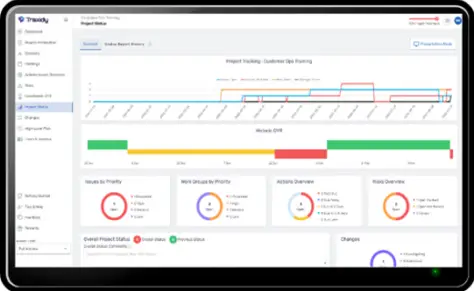

Critical Steps to Handling Project Progress Reporting

By: Steve McBroom, CEO, Traxidy
(Click to follow me on LinkedIn)
How a Project Manager handles the progress reporting of project work items, from the team members, is crucial to project success and the relationships with the team members. Trust is something that can get a Project Manager into trouble. Respect is something the Project Manager (PM) earns through their interaction with team members and key stakeholders. How a PM manages that trust with their team members can gain them respect.
When a team member is entrusted with work to be done on a project, the PM needs to know they can count on the project team member to deliver the expected work. The PM also needs to know that the team member is able to provide an accurate assessment of the project work item progress to date.
To ensure the Project Manager is successful, we have some tips for managing and assessing the work item progress reported from team members.
Remember that collecting the assessment of the progress of each piece of project work on a regular basis is something that you need to do to keep the project on track and the team focused on the end goals. Regular project team meetings is a good place to start.
The PM has two main responsibilities affected by collecting this information:
- The PM is responsible for the success of the project and having the work done on time is critical to that success. Knowing the progress of the pieces of work over a specific timeframe, may lead you to take corrective actions, before it is too late, to ensure the plan is met.
- The PM is regularly reporting the current status of the entire project and its progress to date, to key stakeholders. The knowledge of the progress of each individual piece of work, leads to the accuracy of the overall progress of the project.
Team members need to know that they will be listened to and won’t be criticized or seen as a poor performer.
Trust is a Two-Way Street
A project team member wants to be able to trust the Project Manager and the team environment, to safely present information. Each team member needs to be at ease with saying when things are not going well. If they speak up with issues they may be having, they need to know that they will be listened to and won’t be criticized or seen as a poor performer. Team members need to be able to trust the PM and the team and know that presenting a potential project issue will not be seen as a reflection on them or their capabilities to perform. Without that safe environment, key information may not be presented by the team member, for fear of reprisals, until it’s too late.
The PM wants to trust the team member and needs the team member to be accurate with their evaluation and assessment of project work progress. A further piece of information expected from the team member, is the amount of time required to complete the work, or the Estimate to Complete. Insight into how the PM can best gauge the ability of each team member to provide an accurate estimate of the time it will take to complete work items, is a discussion for another time.
Show Me Please
An experienced Project Manager knows they can’t wait until the due date of the work to find out whether the work will or will not (!) be delivered on time. The PM needs to ask how far along the team member is with their work, or a regular basis, and sometimes they may even need to say… “Show me your work please.”
For some pieces of work, the current progress is relatively easy to measure. For something like a technical document or training package, a review of topics completed or current information may be enough. As some pieces of work progress, it can be more difficult for the PM to judge or check the amount of work that has been done.
A Little Help Here?
The PM needs to realize that sometimes they may not be the best person to assess the work because of lack of knowledge or experience. For work like setting up server architecture, security firewall rules or developing an additional element for an application, it may be more difficult to determine how far along the team member is. No matter what the work is, the Project Manager needs to be comfortable with the team member’s evaluation, or find another way to get comfortable, especially if this is a key piece of work in the project.
To improve the accuracy for reporting work progress and the overall project status update, Project Managers can:
- get a second opinion from another source or Subject Matter Expert that is familiar with the work being done
- have the work reviewed by the very people (on the team or not) that will be the end user or ‘customer’ of the work or output
Just the Progress is Not Enough
Just because you hear that the progress of the work or task is 30% complete, doesn’t really mean anything on its own. Knowing how to manage that information is critical to the project’s success.
The first piece of information the PM needs to know, is the elapsed time to date since the work started. Compare that to the total planned duration of time for the specific piece of project work. If 3 days have elapsed since the start of the work and it is planned to take a total of 15 days, then 3/15 is 20%. We’ll call this the Time Duration Complete (TDC). A comparison of the work item progress to the TDC can be used as an early sign of potential trouble with this piece of work.
An Example
The TDC is the number of days since the task began compared to the total number of days the task is planned to take. Let’s assume a scenario in which the task began 5 days ago, and we know the entire task is planned to take 10 days. So we then have a TDC of 5/10 or 50%. Now, if the team member tells you that the work progress to date is 30% (or 30% of the work is done), then comparing the TDC of 50% to the progress of only 30%, will mean more information is needed. You would normally expect the progress to be closer to the TDC of 50%. Until you learn more, this could be the early sign of a problem.
Note: Not all work is done evenly, day after day. The reality may be that the work is “back-loaded” and much of the work will be done in the later portion of the timeframe, or it could also be “front-loaded” and the majority of work is to be done in the earliest days of the timeframe. This is something the team member should let you know.
Like a lot of ratios or comparisons or subjective assessments in projects, the percentage of progress complete to date, when compared to the Time Duration Complete, can serve to drive conversations to obtain further information and lead you to clarify the situation.
Break the Length of Work Into Manageable Pieces
Project Managers can’t always have a detailed knowledge of the work or the outputs of that project work.
The task may take three weeks. Do you really want to learn, on the last day, that it’s not done?
There is often a ‘long bar’ in the project plan chart that signifies work will be going on over a relatively long time period. If you get to be part of the planning, you may want to have a better understanding of the pieces of work to be done. Even if it’s the same person doing the work over this timeframe, it’s better to break the longer pieces of work effort into smaller pieces. Each shown specifically in the plan. That way it’s easier to assess progress on each smaller piece of work as it’s executed. A good rule of thumb is to not have any one work item or task longer than two weeks.
For all the pieces of project work, ensure the assessment of progress is taken at regular intervals along the way. The task may take three weeks. Do you really want to learn, on the last day, that it’s not done?
Conclusions
As a project leader, ensure your project team members trust that they can bring forward potential project issues as early as possible. Ask to see the current information or work as needed. Bring in a Subject Matter Expert or check with the customer that will be receiving the output, to gauge their acceptance as the work is done. Understand the work, to the point that you can assess the progress compared to the portion of time already used for the work. This will help to ensure it will be completed and delivered on time.
Discover how Traxidy helps Project Managers to manage, measure and report on project work progress to help improve the accuracy of the overall Project Status update and ensure the Project Manager and team is successful. Learn more about the Traxidy features and Project Status updates area here.
Sign up for our Project Manager Insights
Be the first to receive our Traxidy Blog and Project Manager Insights right to your in-box.

















